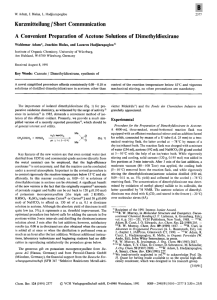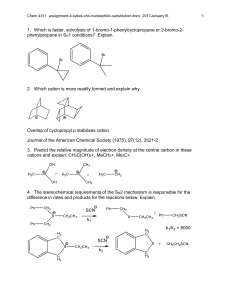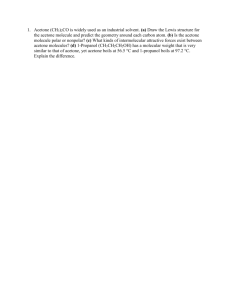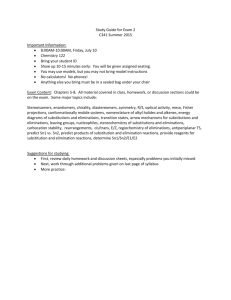lab #6: kinetic investigation of substitution
advertisement
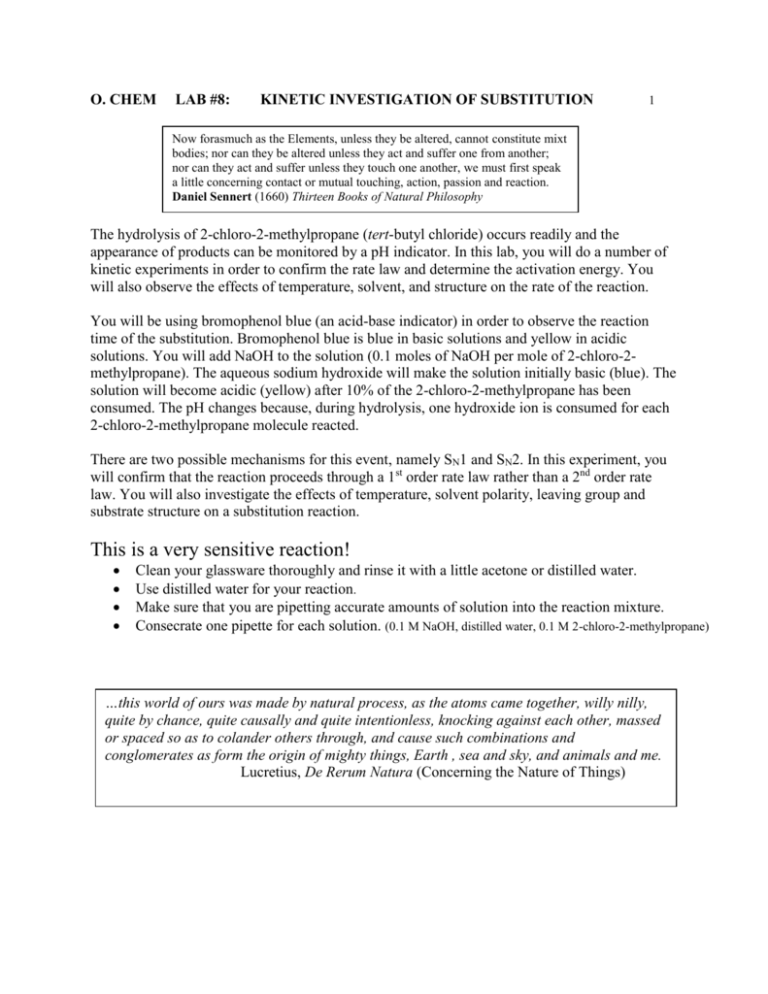
O. CHEM LAB #8: KINETIC INVESTIGATION OF SUBSTITUTION 1 Now forasmuch as the Elements, unless they be altered, cannot constitute mixt bodies; nor can they be altered unless they act and suffer one from another; nor can they act and suffer unless they touch one another, we must first speak a little concerning contact or mutual touching, action, passion and reaction. Daniel Sennert (1660) Thirteen Books of Natural Philosophy The hydrolysis of 2-chloro-2-methylpropane (tert-butyl chloride) occurs readily and the appearance of products can be monitored by a pH indicator. In this lab, you will do a number of kinetic experiments in order to confirm the rate law and determine the activation energy. You will also observe the effects of temperature, solvent, and structure on the rate of the reaction. You will be using bromophenol blue (an acid-base indicator) in order to observe the reaction time of the substitution. Bromophenol blue is blue in basic solutions and yellow in acidic solutions. You will add NaOH to the solution (0.1 moles of NaOH per mole of 2-chloro-2methylpropane). The aqueous sodium hydroxide will make the solution initially basic (blue). The solution will become acidic (yellow) after 10% of the 2-chloro-2-methylpropane has been consumed. The pH changes because, during hydrolysis, one hydroxide ion is consumed for each 2-chloro-2-methylpropane molecule reacted. There are two possible mechanisms for this event, namely SN1 and SN2. In this experiment, you will confirm that the reaction proceeds through a 1st order rate law rather than a 2nd order rate law. You will also investigate the effects of temperature, solvent polarity, leaving group and substrate structure on a substitution reaction. This is a very sensitive reaction! Clean your glassware thoroughly and rinse it with a little acetone or distilled water. Use distilled water for your reaction. Make sure that you are pipetting accurate amounts of solution into the reaction mixture. Consecrate one pipette for each solution. (0.1 M NaOH, distilled water, 0.1 M 2-chloro-2-methylpropane) …this world of ours was made by natural process, as the atoms came together, willy nilly, quite by chance, quite causally and quite intentionless, knocking against each other, massed or spaced so as to colander others through, and cause such combinations and conglomerates as form the origin of mighty things, Earth , sea and sky, and animals and me. Lucretius, De Rerum Natura (Concerning the Nature of Things) O. CHEM LAB #8: KINETIC INVESTIGATION OF SUBSTITUTION 2 Reaction Kinetics: Consider the reaction: A + B C + D For first order rate (SN1): Rate = k1[A] = how much reactant A is disappearing as a function of time After an agonizing derivation based on the interval t = 0 to t = t we have: ln([A] o/[A]) = k1t ln = natural log [A] = concentration reactant A (in moles/liter or “M”) [A]o = [A] at t = 0 k1 = rate constant (s-1) t = time (s) •for a reaction that is 10% completed: [A] = 0.9[A]o then t = (ln10/9)/ k1 Since the relationship between time (t) and the rate constant (k1) then the reaction time should be the same for the reaction regardless of the concentration of reactant A. In other words if you do two trials with the initial concentrations of A being [A]o and [A]o’ then t = t’ for a first order reaction. Sections 8.1 and 8.8 in Bruice cover kinetics for SN2 and SN1 reactions respectively. “Did you never study atomics when you were a lad?” asked the Sergeant giving me a look of great surprise. “No,” I answered. “That is a very serious defalcation,” he said, “but all the same I will tell you the size of it. Everything is composed of small particles of itself and they are flying around in concentric circles and arcs and segments and innumerable other geometrical figures too numerous to mention collectively, never standing still or resting but spinning away and darting hither and thither and back again, all the time on the go. These diminutive gentlemen are called atoms. Do you follow me intelligently?” “Yes.” “They are as lively as twenty leprechauns doing a jig on top of a tombstone.” Brian O’Nolan 1967 from the” The Third Policman” O. CHEM LAB #8: KINETIC INVESTIGATION OF SUBSTITUTION 3 Arrhenius Plot: The Arrhenius equation is an empirical law that describes the relationship between an activation energy and the rate constant at a given temperature. k = Ae-Ea/RT k = rate constant Ea = activation energy (cal/mol) R = gas constant (1.99 cal/mole•K) A = Arrhenius constant T = temperature in K (Kelvin) e = exponential function (2.71828 . . .) ln = natural log Using the rate constants at all available (at least 6) different temperatures, you should be able to estimate the activation energy of the reaction. This is done by rearranging the Arrhenius equation into the following form: ln k = -(Ea/1.99)(1/T) + constant which resembles the equation for a straight line: y = mx + b. Plot your data (x = T-1, y = ln k) on either graph paper or using a spreadsheet or graphing program on the computer. Ea in kcal/mole = -slope(1.99)(0.001) To throw away the key and walk away, Not abrupt exile, the neighbors asking why But following a line with left and right, An altered gradient at another rate. W(ystan) H(ugh) Auden, The Journey O. CHEM LAB #8: KINETIC INVESTIGATION OF SUBSTITUTION 4 Sample Arrhenius Plot: t (sec) (ln(10/9))/t lnk T (C) T (K) 1/T lnk 290 0.000363 -7.92025 19 292 0.003425 -7.92025 150 0.000702 -7.261 22 295 0.00339 -7.261 67 0.001573 -6.45506 25 298 0.003356 -6.45506 33 0.003193 -5.74687 28 301 0.003322 -5.74687 34.5 0.003054 -5.79133 31 304 0.003289 -5.79133 29 0.003633 -5.61766 34 307 0.003257 -5.61766 19 0.005545 -5.19481 37 310 0.003226 -5.19481 Arrenhius Plot lnK 0.0032 0.00325 0.0033 0.00335 0.0034 0.00345 y = -13130x + 37.354 -8 1/T Ea = -slope(1.99) = -(13130)(1.99) = 26,129 cal/mole.K = 26 kcal/mole O. CHEM LAB #8: KINETIC INVESTIGATION OF SUBSTITUTION 5 Pipetting Technique Liquid is drawn up the pipette by the suction created by a rubber bulb or pipetting instrument. Care should be taken to avoid getting liquid inside the rubber bulb as this will contaminate other samples that are being pipetted by the same bulb. When measuring the amount of liquid, align the bottom of the meniscus with the calibration mark. Draw the liquid a centimeter or two above the calibration mark. Remove the bulb and place your finger over the pipette to keep the liquid from running out. Touch the tip of the pipette to the side of the container from which you withdrew liquid; this removes the hanging drop. Move the pipette over to the receiving container. Take you finger off the top and allow the liquid to flow out naturally. Finally touch the tip of the pipette to the side of the container to remove the hanging drop. Often a small amount of liquid stays in the tip. This is normal, the pipettes are calibrated to compensate for this phenomenon. Do not force out any liquid! 1.5 mL substrate 0 .2 .4 .6 .8 1 .15 mL NaOH 0 .02 .04 .06 .08 .1 0 1 3.35 mL 2 3 4 water If you determine your course With force or speed, You miss the way of the law. Quietly consider What is right and what is wrong. Receiving all opinion equally. Without haste, wisely, Observe the law. The Dhammapda O. CHEM LAB #8: KINETIC INVESTIGATION OF SUBSTITUTION 6 This experiment may be performed in groups of two. Each person should complete his/her own lab report. A. GENERAL PROCEDURE: Repeat the following procedure three times. Record the time from the initial mixing of the reactants to the blue-to-yellow color change. Also record the solvent temperature. Determine the average time in seconds of your three trials. You will need about 30 mL of 0.1 M 2-chloro-2methylpropane in acetone for the whole experiment. 1. Pipette 1.5 mL (using a 2 mL graduated pipette) of a 0.1 M solution of 2-chloro-2methylpropane in acetone into a 25 mL Erlenmeyer flask and place the flask on white paper. 2. Pipette 0.15 mL (using a 2/10 mL graduated pipette) of 0.1 M sodium hydroxide (NaOH) solution into a 25 mL flask and add 3.35 mL (using a 5 mL graduated pipette) of distilled water. Add one or two drops of bromophenol blue indicator solution. Do the same thing each time. 3. Note the time and quickly pour the acetone solution into the water solution, swirl for a second, and immediately pour the solution back into the other flask. (This procedure will ensure complete mixing.) Note the time the indicator changes color. Before beginning each experiment, the two flasks should be rinsed with acetone and drained (use a large beaker for waste). B. CONCENTRATION EFFECT Use the experimental procedure described in part A, but before the two solutions are mixed, add 5.0 mL of a 70% water/ 30% acetone (by volume) solution to the flask that contains the aqueous sodium hydroxide. To make the water/acetone mix put 14 mL of water in a 20 or 25 mL graduated cylinder and then add 6 mL of acetone to make a final volume of 20 mL. The experiment is being carried out with the same amount of 2-chloro-2-methylpropane and NaOH but twice the volume of solvent. Therefore, the concentration of these reactants is half that found in part A. Repeat the reaction three times, put the data in a table, and calculate the average reaction time. Now, here, you see, it takes all the running you can do, to stay in the same place. If you want to get somewhere else, you must run at least twice as fast as that! Lewis Carroll, Through the Looking Glass, Ch. 2 O. CHEM LAB #8: KINETIC INVESTIGATION OF SUBSTITUTION 7 C. TEMPERATURE DEPENDENCE The tendency of the carbon-chlorine bond to rupture will depend on whether a sufficient amount of energy (in the stretching vibration of the bond) is available in the 2-chloro-2-methylpropane molecules. To gather enough data to calculate the activation energy, you need at least 6 different temperatures. You already have the time at room temperature from part A. You now need to gather data at two more temperatures. You will get the rest of the needed data from your lab mates. For each of the following experiments, use the procedure from part A. 1. Prepare a water bath from a large beaker and adjust the temperature (with crushed ice) to the given temperature (ask your instructor) below room temperature. Again, follow the procedure of part A but before you mix the two solutions, allow the temperature of the Erlenmeyer flasks to equilibrate to the water bath for about 5 minutes. Repeat the reaction twice. (Do not wait more than 15 minutes for the color change.) 2. Warm the large beaker of water to the given temperature (ask your instructor) above room temperature and repeat the preceding experiment twice (three times in all). Record all the results in a table in your notebook. D. SOLVENT EFFECTS Using two Erlenmeyer flasks, pipette 1 mL of the 0.1 M solution of 2-chloro-2-methylpropane in acetone into one of the flasks and 0.1 mL of the 0.1 M sodium hydroxide solution plus 3.9 mL of water and one or two drops of bromophenol blue indicator into the other. You have just changed the overall solvent composition from 70% water/30% acetone to 80% water/ 20% acetone. Carry out the reaction three times as described in part A and record the results. E. LEAVING GROUP EFFECTS Carry out the procedure in part A with 2-bromo-2-methylpropane. You may do the reaction just one time. F. STRUCTURAL EFFECTS Carry out the procedure in part A with 1-chlorobutane and 2-chlorobutane. Do not wait more than 5 minutes for a color change reaction. You may do each reaction just one time. G. DATA ENTRY: Record your group’s data on the lab laptop (labtop?) before you leave. DISPOSAL PROCEDURES All reaction solutions should go into the labeled container in the hood. O. CHEM LAB #8: KINETIC INVESTIGATION OF SUBSTITUTION Checklist for completing the "Prelab" section: (refer to Laboratory Syllabus for complete directions) ____ Title. ____ Purpose. (1 point) Physical constants. Create a table of physical constants, solubility and safety data for: Name Formula M.W. g/mole m.p. oC b.p. oC Density g/mL 2-chloro-2methylpropane 2-bromo-2methylpropane 1-chlorobutane C4H9Cl 92.57 -26.5 51.0 0.847 C4H9Br 137.02 -16.3 73.3 1.2125 C4H9Cl 92.57 -123 79 0.88 2-chlorobutane C4H9Cl 92.57 -140 68-70 0.87 bromophenol blue C19H10Br4O5S 669.97 pKa = 4.0 pH = 3.0 yellow pH = 4.6 purple/blue tetrabromophenolsulfonephthalein acetone (2-propanone) water C3H6O 58.08 -94 56.5 0.788 H2O 18.02 0 100 aqueous sodium hydroxide NaOH 40.0 1M sol ~0 1M sol. ~100 1.00 g/mL at 19C 1 M sol. ~1.0 Name 2-chloro-2methylpropane 2-bromo-2methylpropane 1-chlorobutane 2-chlorobutane bromophenol blue acetone water aqueous sodium hydroxide References: Solubility Immiscible in water, miscible with alcohols and nonpolar sovents Immiscible in water, miscible with alcohols and nonpolar sovents Immiscible in water, miscible with alcohols and nonpolar sovents Immiscible in water, miscible with alcohols and nonpolar sovents Soluble in water, alcohol and nonpolar solvents Miscible with water, alcohol and non-polar solvents miscible in alcohols, immisc w/ nonpolar solvents sol in water, sol in alc, insol in nonpolar solvents Safety Information Avoid exposure to skin, eyes and mucous membranes. Flammable with toxic fumes. Avoid exposure to skin, eyes and mucous membranes. Flammable with toxic fumes. Avoid exposure to skin, eyes and mucous membranes. Flammable with toxic fumes. Avoid exposure to skin, eyes and mucous membranes. Flammable with toxic fumes. Moderately toxic. Dangerous in a fire. Volatile and flammable. Moderately toxic Avoid breathing fumes. Safe Corrosive and irritating to skin, eyes and mucous membranes. Avoid skin contact 1) Merck Index, 11th ed. 2) www.chemfinder.com 3) Hazardous Chemical Desk Reference, Lewis and Sax, 1987 4) Aldrich catalog online 8 O. CHEM LAB #8: KINETIC INVESTIGATION OF SUBSTITUTION 9 Structures and equations. ____ (1 point) Write a balanced equation, with structures, of the substitution reaction between 2-chloro-2methylpropane and NaOH. ____ (0.5 point) Write the rate equation of an SN1 reaction between 2-chloro-2-methylpropane and NaOH. ____ (0.5 point) Write the rate equation of an SN2 reaction between 2-chloro-2-methylpropane and NaOH ___ Flowchart. (1 point) Calculations. (1 point) Calculate the molarity [moles/liter] of 2-chloro-2-methylpropane and NaOH in the reaction solution for parts A and B. Show your calculations. (1 point) Given Ken Etic’s data set, determine Ea for the reaction between 2-bromo-2methylpropane and sodium methoxide. Fill in the table and show your Ea caluculation. Reaction: (CH3) 3C-Br + NaOCH3 (CH3) 3C-OCH3 + NaBr Temp (ºC) 19 ºC 22 25 28 31 34 37 T (Kelvin) 1/T t for 10% completion 217 s 106 78.1 53 50 26 17.5 k = (ln10/9)/t lnk Experimental Observations and Data: Hand in a copy of your experimental observations and data before you leave the lab. Experimental Observations. (4 points) ___ Who was your partner? ___ What was the appearance of each of the reagents? ___ What color change did you observe? ___ How many drops of indicator did you add each time? ___ How did you time the reaction? ___ Any blunders to report? ___ Did you record any other interesting sights and smells? Data: ___ Have you clearly labeled parts A, B, C, D, E & F? ___ Please share your part C data with the class. O. CHEM LAB #8: KINETIC INVESTIGATION OF SUBSTITUTION 10 Lab Report Checklist: Results. ___ (1 point) Create a table to organize your raw and averaged data. If presenting class data, indicate which is yours. ___ (2 points) How does your data compare with the class data? Be specific. For example, compare your data to class average for a given section. ____(2 points) Determine the energy of activation from the data from part C. Hand in your plot. Show your calculations. Discussion and Conclusion. ____ (1 point) Does your data confirm that the reaction is first order? Explain how your experimental data from parts A & B fits with what you are learning about SN1 and SN2 reactions (refer to page 2). ____ (1 point) What temperature dependence did you observe in part C? If temperature (T) is in the denominator on the left side of the Arrenhius equation why are k and T directly proportional (k increases as T increases). ____ (1 point) What solvent effects did you observe in part D? Explain how your experimental observations on solvent polarity vs. reaction time fit with what you are learning about SN1 and SN2 reactions. ____ (1 point) What differences between leaving groups did you observe in part E? Explain how your experimental observations fit with what you are learning about SN1 and SN2 reactions. ____ (1 point) What structural effects did you observe in part F? Explain how your experimental observations fit with what you are learning about SN1 and SN2 reactions.




